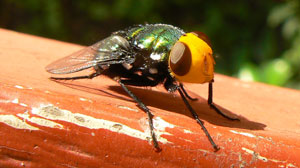 Dr. David O'Carroll's lab at the University of Adelaide is currently working in the area of insect vision. His research asks how the brain makes sense of the world viewed by the eye. Insects are ideal for tackling this problem at theoretical, physiological and behavioral levels. With a visual system that accounts for as much as 30% of the lifted mass, some flying insects invest more in vision than any other animal. What happens to the abundance of information collected by such large eyes? How has the brain evolved to optimally extract the features from scenes that are most relevant to the behavior adopted?
Dr. David O'Carroll's lab at the University of Adelaide is currently working in the area of insect vision. His research asks how the brain makes sense of the world viewed by the eye. Insects are ideal for tackling this problem at theoretical, physiological and behavioral levels. With a visual system that accounts for as much as 30% of the lifted mass, some flying insects invest more in vision than any other animal. What happens to the abundance of information collected by such large eyes? How has the brain evolved to optimally extract the features from scenes that are most relevant to the behavior adopted?
A large part of their current effort is directed at understanding and modelling neurons involved in detection of moving features and 'optical flow' patterns induced by movement by an animal through its habitat. We are also collaborating with Industry to develop robust models for adaptive motion detectors, based on insect vision, for implementation in silicon hardware. Applications for this technology include the aerospace industry, guidance systems for miniature autonomous vehicles and for embedded collision avoidance sensors that can be incorporated into future motor vehicles. More about their current projects...



